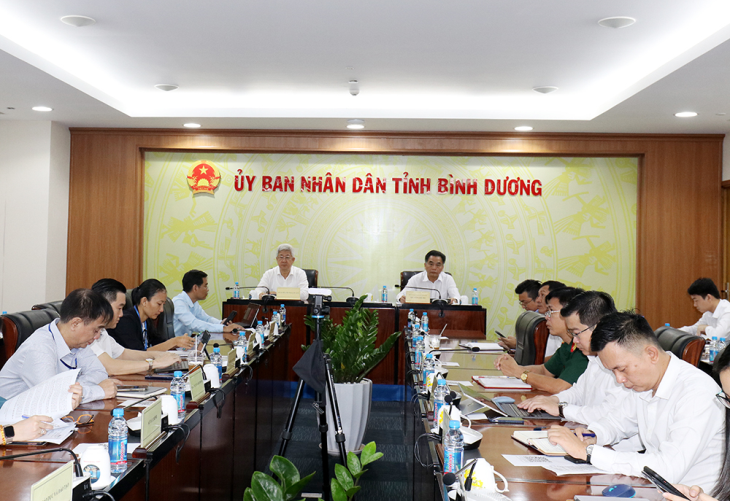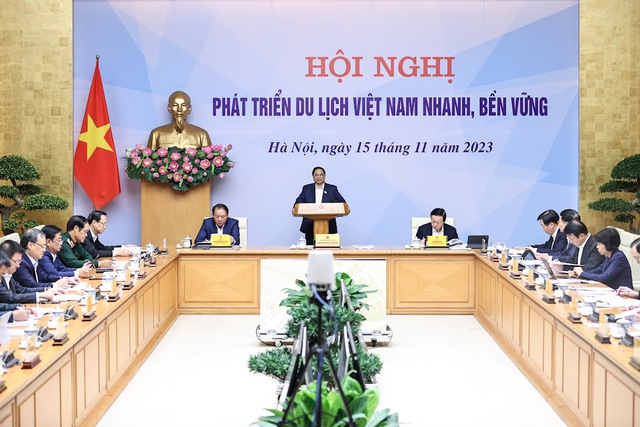Attending were Deputy Prime Minister Tran Hong Ha; leader representatives of ministries and branches; Viet Nam tourism associations and enterprises.
At Binh Duong bridge point, in attendance were Mr. Nguyen Loc Ha - Member of the Provincial Standing Party Committee, Vice Chairman of the Provincial People's Committee (PPC); leader representatives of provincial departments, committees and branches.
According to a report from the Ministry of Culture, Sports and Tourism, on March 15, 2022, Viet Nam's tourism was fully opened to welcome international visitors under new normal conditions. Tourism has gradually recovered. In 2022, total revenue from tourists is estimated to reach 495,000 billion VND, an increase of 2.75 times over the same period. Domestic tourists reached 101.3 million turns, exceeding the target of 60 million turns set at the beginning of the year. The number of newly registered travel enterprises and returning to the tourism sector increased rapidly. Data from Google's market trend tracking tool shows that the number of international searches for Viet Nam's tourism grew by about 50% - 75%, the 4th highest increase in the world. According to the World Economic Forum's Tourism Competitiveness Index ranking in 2021, Viet Nam ranked 52/117 economies, up 8 places compared to 2019. With 6/17 pillar indexes classified as world leading, Viet Nam is one of three countries with the highest growth rate of this ranking index.

Delegates attend at Binh Duong bridge point
In the first 10 months of 2023, the number of international visitors to Viet Nam reached more than 9.97 million turns, exceeding the 2023 plan; domestic visitors reached 98.7 million turns; total revenue from tourists reached more than 582,000 billion VND. Tourism is a bright spot in economic recovery. The results of tourism recovery have a pervasive impact on many areas, contributing to improving the three growth drivers of the economy: investment, export and consumption.
However, Viet Nam's tourism still has problems and difficulties. Specifically, the recovery rate of international tourist arrivals is still low compared to 2019 and compared to the industry's supply capacity; Viet Nam's tourism advertising and promotion activities do not meet the requirements of frequency and coverage to key markets, and cannot organize tourism promotion activities of national scale and stature. Tourism advertising and promotion resources have not been effective. There is no visa policy or specific air connection support to stimulate tourism demand in the new context after the Covid-19 pandemic. Tourism products are not commensurate with their potential and strengths, have low added value, and are not truly diverse and attractive to some tourist markets in the new context. Tourism human resources are lacking because during the pandemic, people have changed industries, especially there is a shortage of skilled and experienced workers, etc.
In the above context, the Viet Nam's tourism branch has set a goal that by 2023, international tourists to Viet Nam will reach from 12 million to 13 million turns (compared to the previous target of 8 million turns of international tourists); domestic tourists about 102 million turns; Total revenue from tourists about 650,000 billion VND. By 2025, the tourism industry will fully recover to its pre-pandemic level, directly contributing 6-8% to GDP.
Discussing solutions for Viet Nam's tourism industry to develop quickly and sustainably in the coming time, according to experts, the tourism industry needs to focus on implementing key solutions and major orientations. Specifically, promoting cooperation between tourism enterprises, creating a healthy and professional competitive business environment, improving service quality in the tourism product value chain; promoting inter-regional and inter-local coordination, forming value chains, tourism products and building a civilized, safe and friendly tourism environment; continuing to strengthen inter-sectoral coordination, researching and proposing mechanisms and policies to further facilitate the recovery and development of tourism; accelerating market restructuring, focusing on drastically implementing tourism promotion activities, and speeding up the recovery of the international tourist market; developing branded tourism products and services with added value and high competitiveness, promoting digital transformation and developing tourism human resources, etc.
At the same time, recommending and proposing to the Government, ministries, branches, localities, associations, and Vietnamese enterprises a number of regimes and policies related to promoting Viet Nam's tourism abroad; discounts and incentives on electricity prices to support tourism enterprises in reducing operating costs and improving competitiveness in attracting tourists; human resource training for the tourism industry; policies to support Vietnamese airlines; opening more routes to potential tourism markets, etc.

Prime Minister Pham Minh Chinh speaks at the conference's conclusion
Speaking at the conference's conclusion, Prime Minister Pham Minh Chinh highly appreciated the results achieved in Viet Nam's tourism development over the past time. At the same time, he requested the Government Office, Ministry of Culture, Sports and Tourism, relevant Ministries and branches to absorb maximum comments at the conference, soon complete and advise the Prime Minister to issue a Directive on comprehensive, fast and sustainable development of the tourism industry. Ministries and branches from Central to local levels pay attention to strengthening information technology application solutions to improve electronic visa issuance processes and procedures; mobilize resources, attract investment for tourism development, especially investment in planned tourist areas and destinations and appropriate connection infrastructure systems and specific tourism products. Accelerating the progress and effectiveness of implementing the Program to restore and develop socio-economics in the local tourism sector, programs and projects to develop tourism infrastructure, products, and advertise and promote tourism. Proactively and effectively participating in inter-local and inter-regional cooperation and linkages to promote tourism development. Creating favorable conditions for tourism enterprises to build and develop new products; simplifying administrative processes and procedures to facilitate tourism promotion.
Tourism enterprises and associations promote their role in supporting member enterprises, especially promoting connection activities, helping enterprises overcome difficulties together, proactively adapt, recover quickly and develop sustainably; innovating business models, restructuring enterprises associated with digital transformation, innovation and creativity, etc.